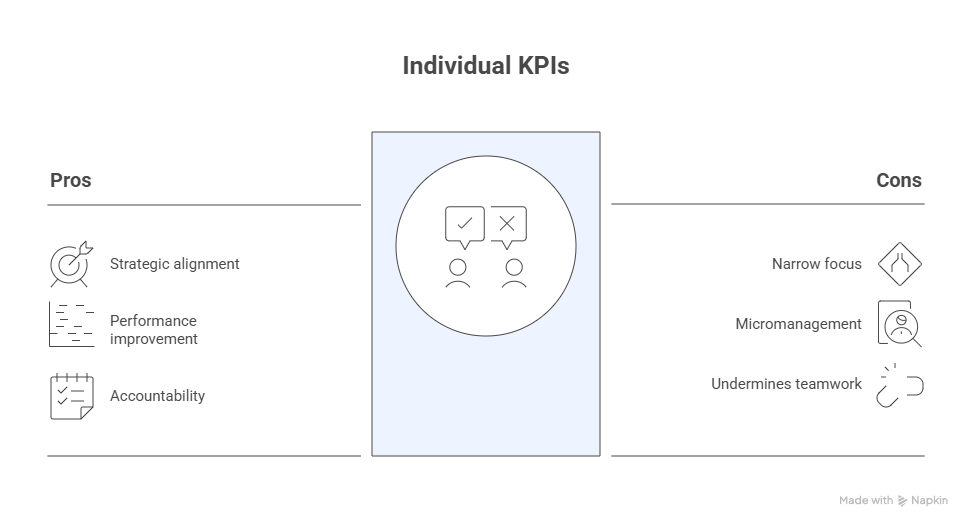The Evolution of Key Performance Indicators (KPIs): From Concept to Cornerstone
Executive Summary
This article explores the history and evolution of Key Performance Indicators (KPIs) as critical tools for strategic and operational management.
What You’ll Learn
- The origins and early development of Key Performance Indicators (KPIs) and their pioneers
- How KPIs evolved from executive metrics to organization-wide performance tools
- The transformative impact of Kaplan and Norton’s Balanced Scorecard on KPI usage
- The role of data analytics, real-time business intelligence, and digital transformation in modern KPIs
- The emergence of Objectives and Key Results (OKRs) as a complement to traditional KPIs
- Practical insights into the adoption, resistance, and adaptation of KPIs across sectors and levels
- Thought leadership from influential KPI experts shaping today’s performance management landscape
Introduction.The Birth of KPIs as a Strategic Management Tool
The concept of Key Performance Indicators (KPIs) emerged in the late 20th century as businesses sought better ways to measure and manage performance in increasingly complex environments.
While metrics and performance measurement had long been part of management practices, the specific term “Key Performance Indicators” began to take shape during the late 1970s and early 1980s, thanks to the insights of several pioneering thinkers.
The Origin Story: Early Pioneers Who Shaped KPI Fundamentals
John F. Rockart: Introducing KPIs as Essential Executive Metrics (1979)
John F. Rockart (1921-2010), a professor at MIT Sloan School of Management, was among the earliest to crystallize the idea of KPIs. In 1979, Rockart introduced the term in his work on executive information systems, emphasizing the need for senior executives to focus on a limited set of critical metrics.
He defined KPIs as “those indicators that focus on the critical aspects of performance that are essential for the organization’s current and future success.” Rockart’s influence was particularly significant due to his work on executive information systems, underscoring the informational foundation businesses needed to make strategic decisions.
His work laid the groundwork for what would become a cornerstone of modern management practices.
D. Otley: Aligning KPIs with Strategic Priorities for Organizational Success (1980)
Otley, a prominent figure in the field of management accounting, took Rockart’s concept a step further. In 1980, Otley’s research in “Management Accounting” explored how KPIs could be aligned with strategic priorities and provide meaningful insights into performance.
Otley’s academic rigor helped solidify the importance of KPIs in strategic planning, ensuring that these indicators were not just metrics but powerful tools for driving organizational success.
A. K. Mital: Leveraging KPIs to Drive Coherent Strategic Decision-Making (1981)
Mital, whose 1981 article in the “Strategic Management Journal” remains a key reference in KPI literature, emphasized the role of KPIs in strategic decision-making.
Mital argued that by defining key performance indicators, organizations can ensure that all levels of management are aligned with the overall strategy and are working towards common goals. His work reinforced the idea that KPIs could bridge the gap between high-level strategy and day-to-day operations, making them an essential tool for any forward-thinking organization.
E. D. Chow: Developing KPIs That Are Actionable and Strategic (1982)
Chow, a notable figure in business strategy, contributed significantly to the practical application of KPIs with his 1982 article in the “Journal of Business Strategy.” Chow’s work focused on the development and implementation of KPIs, stressing that these indicators should be actionable and directly tied to strategic goals.
He noted that “key performance indicators should be developed in a way that they provide actionable insights and drive organizational success,” emphasizing that KPIs needed to be more than just numbers on a report—they had to be tools that managers could use to effect real change.
Together, these early contributions set the foundation for the widespread adoption of KPIs in business management.
The work of Rockart, Otley, Mital, and Chow transformed KPIs from a theoretical concept into a practical, indispensable component of modern management practices.
KPIs Gaining Traction: Becoming Integral to Strategic Management
Kaplan and Norton: Revolutionizing KPI Use with the Balanced Scorecard (1992)
The 1990s marked a significant turning point for KPIs, largely due to the groundbreaking work of Robert Kaplan (born 1940) and David Norton (1941-2020). In 1992, Kaplan and Norton introduced the Balanced Scorecard, a revolutionary framework that emphasized the importance of linking performance measures to an organization’s strategic objectives.
They famously stated, “the Balanced Scorecard translates an organization’s vision and strategy into a coherent set of performance measures,” which, in practice, often took the form of KPIs tailored to each strategic area. Their approach allowed businesses to move beyond traditional financial metrics, incorporating KPIs that measured customer satisfaction, internal processes, and learning and growth.
For investors today, understanding ROI in practice through the Balanced Scorecard framework remains crucial for evaluating portfolio performance across multiple dimensions.
The Shift to Departmental and Individual-Level KPIs
Initially, KPIs were primarily applied at the corporate level to measure the effectiveness of overall strategy. However, Kaplan and Norton’s Balanced Scorecard framework also laid the groundwork for applying KPIs at the departmental and individual levels, where every part of the organization—from customers to strategy and growth—becomes a critical component of success.
By breaking down strategic objectives into specific, actionable KPIs for different levels within the organization, Kaplan and Norton promoted a more integrated approach to performance management, where every part of the organization contributed to the overarching goals.
This shift began in the mid-1990s as organizations recognized the need to ensure that all employees, not just top executives, were aligned with the company’s strategy. By applying KPIs at the departmental and individual levels, organizations could better track performance and ensure each employee was contributing to collective success.
However, proponents like Kaplan, Norton, and Niven have countered these concerns by emphasizing the importance of aligning KPIs with overall strategy to ensure that they drive the right behaviors across the organization.
Paul Niven: Expanding KPIs Beyond Corporate Strategy (2002)
Paul Niven played a crucial role in advocating for the use of KPIs at all organizational levels, particularly in the public and nonprofit sectors. In his 2002 book, “Balanced Scorecard: Step-by-Step for Government and Nonprofit Agencies,” Niven emphasized that KPIs should be adapted to fit different organizational contexts, including at the department and individual levels.
He highlighted that aligning KPIs with strategic objectives was not just for corporate management but was essential for any organization, regardless of sector, to ensure that they were working towards the same goals. Niven’s work demonstrates how KPIs could be effectively applied across various levels, making them a versatile tool for improving performance in diverse settings.
Resistance to Departmental and Individual KPIs
Despite the widespread adoption of KPIs at multiple levels within organizations, there has been some resistance to this approach. Critics argue that when KPIs are applied at the individual level they can sometimes lead to a narrow focus on metrics rather than broader organizational goals, potentially fostering a culture of micromanagement.
Some opponents also caution that overemphasis on individual KPIs might undermine teamwork and collaboration, as employees might focus more on meeting their own targets than contributing to collective success.
However, proponents like Kaplan, Norton, and Niven have countered these concerns by emphasizing the importance of aligning KPIs with overall strategy to ensure that they drive the right behaviors across the organization.
Data Analytics Boom: Enhancing KPIs with Real-Time Data and Business Intelligence
The late 1990s and early 2000s saw the rise of data analytics and business intelligence (BI) tools, which further accelerated the popularity of KPIs across all levels of an organization.
Organizations gained the ability to collect, analyze, and report data in real-time, making it easier to track KPIs and respond swiftly to changes in performance.
Kaplan and Norton’s 2000 work, “Strategy-Focused Organization: How Balanced Scorecard Companies Thrive in the New Business Environment”, was instrumental in demonstrating how KPIs could be leveraged in this new data-driven era, moving toward more dynamic and data-driven management practices.
By the early 2000s, KPIs had become a ubiquitous part of the business lexicon, seen as critical components of both strategic management and operational execution at every level.
KPIs in the Modern Era: Transforming Business Through Measurement
Bernard Marr: Elevating KPI Use in Data Strategy and Performance Management (2015)
Bernard Marr, born in 1967, has emerged as one of the most influential figures in modern KPI advocacy. His 2015 book, “Key Performance Indicators: The 75+ Measures Every Manager Needs to Know,” provides a comprehensive guide to selecting and implementing KPIs across various business functions, from corporate strategy to individual performance.
Marr emphasizes that “KPIs are much more than numbers; they are a vital part of the story of your business.” His ability to translate complex business concepts into actionable insights has made his work particularly impactful, helping businesses of all sizes understand how to use KPIs effectively to drive performance at every level.
David Parmenter: Focusing on Impactful and Practical KPIs for Success (2007)
David Parmenter, born in 1947, is known for his practical approach to performance management. His 2007 book, “Key Performance Indicators: Developing, Implementing, and Using Winning KPIs,” offers a detailed methodology for creating KPIs that truly reflect an organization’s success factors at both macro and micro levels.
He writes, “The key to developing effective KPIs is to focus on what truly matters, whether at the corporate, departmental, or individual level.” Parmenter’s emphasis on the practical application of KPIs has made his book a go-to resource for organizations seeking to refine their performance measurement systems.
Jim Collins: Simplifying KPIs for Strategic Alignment and Organizational Focus (2001)
While Jim Collins (born 1958) is not solely focused on KPIs, his work has significantly influenced the modern discourse on performance management. In his books “Good to Great” (2001) and “Built to Last: Successful Habits of Visionary Companies” (1994), Collins emphasizes the importance of having a clear definition of what an organization is deeply passionate about, what it can be the best in the world at, and what drives its economic engine.
He suggests that KPIs should align with this concept to ensure they measure what truly matters, whether at the corporate, departmental, or individual level. Collins’s emphasis on simplicity in KPIs has inspired many organizations to focus on metrics directly tied to their long-term vision and strategy.
Thomas H. Davenport: Integrating KPIs with Advanced Analytics for Strategic Wins (2007)
In the realm of data analytics and digital transformation, Thomas H. Davenport stands out as a key proponent of using KPIs within the broader context of data-driven decision-making. In his book “Competing on Analytics: The New Science of Winning” (2007), co-authored with Jeanne G. Harris, Davenport discusses how leading companies use data and analytics to gain a competitive edge, with KPIs serving as critical tools in this process.
He argues that “the best organizations base their KPIs on the most reliable data and use them not just to measure performance but to inform strategic decisions.” Davenport’s work has been pivotal in showing how KPIs can be leveraged in the age of big data to drive success at every organizational level.
Paul Niven: Maximizing Performance Across Sectors (2006)
In his later book, “Balanced Scorecard Step-by-Step: Maximizing Performance and Maintaining Results” (2006), Niven offers a comprehensive guide to implementing the Balanced Scorecard across various sectors, including private, public, and nonprofit organizations.
This work emphasizes the practical steps needed to maximize performance and maintain long-term results using KPIs as part of a broader performance management system.
The Next Phase: KPIs and OKRs Adapting to a Rapidly Changing World
OKRs Emerge: A Dynamic Framework to Complement and Enhance Traditional KPIs
As organizations continued to refine their performance management systems, another framework began to rise in prominence alongside KPIs: Objectives and Key Results (OKRs). Originating at Intel in the 1970s and later popularized by Google, OKRs are a goal-setting methodology designed to align individual, team, and organizational objectives with measurable outcomes.
John Doerr (born 1951), a venture capitalist who introduced OKRs to Google, described them in his 2018 book, “Measure What Matters: How Google, Bono, and the Gates Foundation Rock the World with OKRs,” as a simple idea that drives focus, alignment, and engagement around measurable goals that push teams beyond their current capabilities.
Unlike KPIs, which focus on measuring ongoing performance against predefined benchmarks, OKRs are typically more dynamic, emphasizing stretch goals that push teams beyond their current capabilities. This represents goal setting that drives action in modern organizations.
Ben Lamorte: Integrating OKRs and KPIs to Maintain Strategic Focus and Drive Results
Ben Lamorte, a leading expert on OKRs and author of the 2021 book “The OKRs Field Book: A Step-by-Step Guide for Objectives and Key Results Coaches,” highlights the importance of aligning KPIs with OKRs to drive performance and maintain focus on strategic priorities.
He states, “OKRs are powerful tools, but they must be supported by relevant KPIs that provide clear, measurable evidence of progress.” Lamorte’s approach underscores the importance of using KPIs to ensure that organizations stay on track with their strategic objectives, particularly in dynamic and fast-paced industries.
Stacey Barr: Advocating for KPIs That Drive Continuous Improvement and Success
Stacey Barr, a performance measurement specialist, has been a strong advocate for meaningful and practical KPIs, especially in the context of continuous improvement. Her 2020 book, “Prove It!: How to Create a High-Performance Culture and Measurable Success,” focuses on creating KPIs that are not just numbers but meaningful indicators of success.
Barr emphasizes that KPIs should be directly linked to business processes and outcomes, providing actionable insights that lead to improvement. She writes, “The right KPIs are those that tell us not just where we are, but what we need to do next to improve.”
Bernard Marr: Adapting KPIs for a Future Dominated by Digital Transformation
Bernard Marr continues to influence the conversation with his work focusing on the intersection of KPIs and digital transformation. In his 2020 book, “Tech Trends in Practice: The 25 Technologies That Are Driving the 4th Industrial Revolution,” Marr emphasizes how emerging technologies like artificial intelligence, big data, and the Internet of Things (IoT) are reshaping the way organizations use KPIs.
He argues that “in the era of digital transformation, KPIs must evolve to capture the full impact of technology on business performance.”
Christina Wodtke: Using KPIs and OKRs to Foster Agility in Fast-Paced Environments
Christina Wodtke, a specialist in OKRs and agile management practices, has also been a significant advocate for the strategic use of KPIs in modern organizations. In her 2021 updated edition of “Radical Focus: Achieving Your Most Important Goals with Objectives and Key Results,” Wodtke highlights the importance of combining OKRs with the right KPIs to effectively measure progress and make adjustments quickly.
She emphasizes that “KPIs are essential tools in an agile organization’s toolkit, providing the data needed to pivot when necessary and stay aligned with strategic goals.”
David McCandless: Making KPIs Powerful Through Effective Data Visualization
David McCandless, a data visualization expert, has also contributed to the modern understanding of KPIs by emphasizing the importance of clear communication. In his 2020 work, “Information is Beautiful,” McCandless discusses how visualizing KPIs can make complex data more accessible and actionable for decision-makers.
He argues, “The way we present KPIs can greatly influence how they are understood and used; good data visualization can turn a KPI from a simple metric into a powerful tool for insight and action.”
KPIs in 2025: AI and Predictive Analytics for Investors
AI-Driven KPI Trends in Investment Analytics
As of 2025, KPIs are evolving with AI, turning static metrics into predictive powerhouses for investors. The global predictive analytics market hits $22.1 billion this year, with 65% of organizations adopting AI for data analytics.
For investors, AI enables real-time tracking of portfolio KPIs like Sharpe Ratio or ROI via automated dashboards. Example: Predictive tools forecast market shifts, helping firms like BlackRock optimize investments—75% of venture capital decisions now use AI analytics.
Building on the Balanced Scorecard framework, modern AI-driven KPIs add layers for strategic forecasting, allowing investors to:
- Track forecast accuracy and cash conversion in real-time
- Monitor churn risk and customer lifetime value predictions
- Use dashboards that refresh continuously with live market data
- Tie portfolio KPIs directly to strategic objectives using enhanced Scorecard logic
Key Investment KPIs for 2025:
- Revenue growth rate (predictive models)
- Margin trend analysis (AI-enhanced)
- Asset turnover optimization
- Leverage risk assessment
- Real-time ROI calculations
Note: Data quality and time lags remain critical considerations in AI-powered KPI systems.
Conclusion: KPIs as the Bedrock of Strategic and Operational Excellence
From their origins in the late 1970s to their widespread adoption in the modern era, Key Performance Indicators (KPIs) have become indispensable tools for measuring and driving organizational success. Early pioneers like John F. Rockart and D. Otley laid the foundation for KPIs as a critical component of strategic management, while modern thought leaders like Bernard Marr, David Parmenter, and Thomas H. Davenport have integrated KPIs with advanced analytics and digital transformation strategies.
The evolution of KPIs reflects the broader transformation of business management in response to digital transformation, agile management practices, and the demands of a rapidly changing business environment ensures that they will remain vital tools for organizations striving for excellence in the 21st century.
For investors navigating this complex landscape, understanding how to choose the right KPI framework becomes essential for making data-driven investment decisions in 2025 and beyond.
Bibliography
- Rockart, John F. (1979). *Chief Executives Define Their Own Data Needs*. Harvard Business Review.
- Otley, D. (1980). *The Contingency Theory of Management Accounting: Achievement and Prognosis*. Management Accounting Research.
- Mital, A. K. (1981). *Strategic Management Journal*.
- Chow, E. D. (1982). *Developing Key Performance Indicators for Organizational Success*. Journal of Business Strategy.
- Kaplan, Robert S., & Norton, David P. (1992). *The Balanced Scorecard: Measures That Drive Performance*. Harvard Business Review.
- Kaplan, Robert S., & Norton, David P. (1996). *The Balanced Scorecard: Translating Strategy into Action*. Harvard Business Review Press.
- Kaplan, Robert S., & Norton, David P. (2000). *Strategy-Focused Organization: How Balanced Scorecard Companies Thrive in the New Business Environment*. Harvard Business Review Press.
- Marr, Bernard (2015). *Key Performance Indicators: The 75+ Measures Every Manager Needs to Know*. Pearson.
- Parmenter, David (2007). *Key Performance Indicators: Developing, Implementing, and Using Winning KPIs*. Wiley.
- Collins, Jim (2001). *Good to Great: Why Some Companies Make the Leap and Others Don’t*. HarperBusiness.
- Collins, Jim (1994). *Built to Last: Successful Habits of Visionary Companies*. HarperBusiness.
- Davenport, Thomas H., & Harris, Jeanne G. (2007). *Competing on Analytics: The New Science of Winning*. Harvard Business Review Press.
- Niven, Paul R. (2002). *Balanced Scorecard: Step-by-Step for Government and Nonprofit Agencies*. Wiley.
- Niven, Paul R. (2006). *Balanced Scorecard Step-by-Step: Maximizing Performance and Maintaining Results*. Wiley.
- Doerr, John (2018). *Measure What Matters: OKRs: The Simple Idea that Drives 10x Growth*. Portfolio.
- Lamorte, Ben (2021). *The OKRs Field Book: A Step-by-Step Guide for Objectives and Key Results Coaches*. Wiley.
- Barr, Stacey (2020). *Prove It!: How to Create a High-Performance Culture and Measurable Success*. PuMP Press.
- Marr, Bernard (2020). *Tech Trends in Practice: The 25 Technologies That Are Driving the 4th Industrial Revolution*. Wiley.
- Wodtke, Christina (2021). *Radical Focus: Achieving Your Most Important Goals with Objectives and Key Results*. 2nd Edition. Boxes and Arrows.
- McCandless, David (2020). *Information is Beautiful*. HarperCollins.








